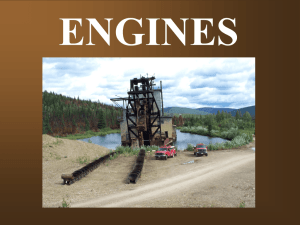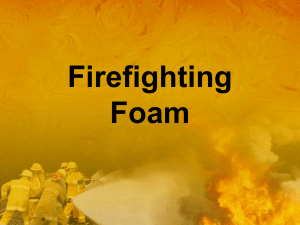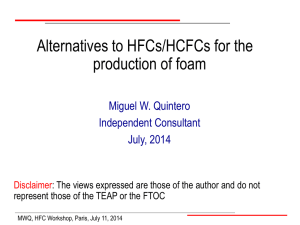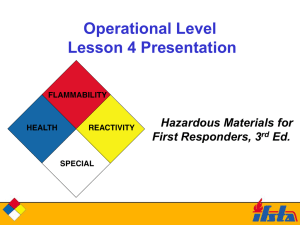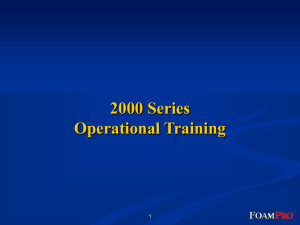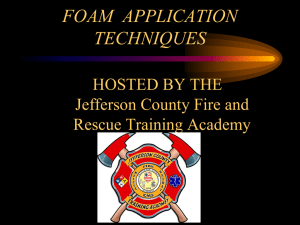working copy - HOME Ship Study
advertisement
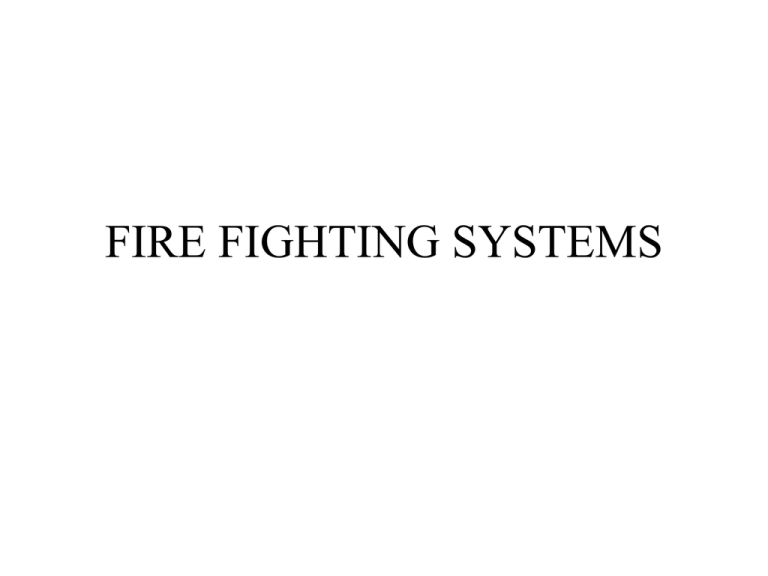
FIRE FIGHTING SYSTEMS Fixed fire fighting systems • A variety of different fixed fire fighting installations exist, some of which are specially designed for certain types of ship. A selection of the more general installations will now be obtained as follow; – – – – – Ship’s fire main system Carbon Dioxide System Water Spray System Foam Systems Inert Gas System Ship’s fire main system • A sea water supply system to fire hydrants is fitted to every ship using several pumps in the engine room with their number and capacity being dictated by legislation. • an emergency fire pump will also be located remote from the machinery space and with independent means of power • A system outlet fitted with isolating valves located around the ship, and hoses with appropriates snapin connectors are strategically located together with jet or spray types nozzles to covered the whole ship area • An international shore connection is always carried onboard with standard flange size which is fitted with a coupling suitable for the ship’s hoses. Emergency Fire Pump • In order to deal with the outbreak of fires, it is required by regulation that an independent pumping unit to be placed on board at such a position that it is away from the main possible seat of fire or damaged by collision • The pump is of a centrifugal type completed with priming unit run by a small diesel engine which is can be started by hand cranking • Unit shall be tested regularly and kept in a state of readiness at all times Pumps requirements • Independent power unit driven by a self cooled compression ignition engine or an electric motor driven by electric power from emergency generator • Independent sea suction with total head suction of the pump shall not exceed 4.5 meter under all conditions of list and trim • Capacity not less than 25cubic meter per hour • Capability to supply two ½ inch bore jets of water having a horizontal throw of 40 feet • All associate components located outside engine room or machinery area • Easy to start and fuel service tank capable to run on full load at least 3 hours operation (15 hours for outside machinery space) CO2 Flooding System • CO2 Flooding System for cargo holds • CO2 Flooding System for machinery space • Bulk Carbon Dioxide System CO2 Flooding System for cargo holds Diverting valve Detecting cabinet generally located in bridge CO2 battery (possibly situated in a deck house) • Gases from the compartment is drawn continuously by suction fans to diverting valve into the wheelhouse through an electrical smoke detector via nylon propellers which should be continuously whirling to indicated sampling tube is not blocked • When a fire breaks out in a compartment, smoke issues from diverting valve into the wheelhouse to sound an electrical smoke detector alarms • Identification of defected compartment can be seen from diffused light from a chimney • Operator would first operate the appropriate change over valve which are generally situated inside the lower portion of the cabinet before releasing requisite number of CO2 cylinders for the compartment. CO2 Flooding System for Machinery space • To be effective in smothering effect, at least 30% of the gross volume of the compartment to be covered and the flooding system must release to obtained 40% of the gross volume of the compartment and held until the fire is out • This system are arranged to release at least 85% of the CO2 capacity within two minutes. • Incase of fire, first evacuated all personnel and sealed off the compartment (engine room) from any ingress of air either manually or automatically or equivalent. • While opening the steel control box situated at the fire control station will operate audible and visual alarms • The CO2 direction valve handle would then be pulled and this would be followed by gas release to the compartment Bulk Carbon Dioxide System • The system was designed to replace the flooding systems for machinery and hold spaces which use a considerable number of bottles consists essentially of one or two pressure tanks and appropriate network of pipes for distributing the gas around the machinery spaces. • Cylindrical container well insulated which hold CO2 at working temperature and pressure about - 20°c and 21 bar. • Duplicated refrigeration units automatically controlled by the pressure of the CO2 are used, one in used other in standby in order to maintained tanks temperature • Since it is essential that pressure in the container maintained for fire extinguishing within set range a heater cuts in is required to increase the pressure of CO2 • Two set of relief valve are fitted which are operated 24.5 bar (Lp)and 27 bar (Hp) venting in the event of fire in the compartment where the container is situated. • Alarms are provided for; – – – – Loss of 5% of contents (low level) Increases up to 98% of free volume (high level) Leakage past main discharge valve Opening of section valve Water Spray System • Automatic Sprinkler System • High Pressure Water Spray System Automatic Sprinkler System • The sprinkler system is an automatic fire detecting, alarm and extinguishing system that is constantly 'on guard' to deal quickly and effectively with any out break of fire that may occur in accommodation or any other spaces. • The system is composed of a pressurised water tank with water pipes leading to various compartments which is occupied with not more than 150 heads per section of sprinkler heads fitted and come into operation when there is an outbreak of fire • Each sprinkler head is made up of a steel cage fitted with a water deflector, a quartzoid bulb, which contains a highly expansible liquid, is retained by the cage. The upper end of the bulb presses against a valve assembly which incorporates a soft metal seal. • The quartzoid bulbs are manufactured with a small gas space is left inside the bulb so that if the bulb is subject to heat, the liquid expands and the gas space diminishes. This will generate pressure inside the bulb and the bulb will shatter once a predetermined temperature (and hence pressure) is reached. • Quartzoid bulbs are manufactured in different colours, the colour indicates the temperature rating for the bulb: – 68oC – Red – 80oC – Yellow – 93oC – Green • Once the bulb is shattered the valve assembly falls permitting water to be discharged from the head, which strikes the deflector plate and sprays over a considerable area. High Pressure Water Spray System • This can be a completely separate system or may interconnected with the sprinkler system used for fire extinguishing in accommodation spaces • The system incorporates an air vessel, fresh water pump and salt water pump all connected to each sections piping which having its own shut-off valve and sprayer heads (no quartzoid bulbs or valves but are open as sprinkler) • The system is full of fresh water under pressure from the compressed air in the air vessel. When a section valve is opened, water will be discharged immediately from the open sprayer heads in that section. • Pressure drop in the system automatically starts the salt water pump which will continue to deliver water to the sprayers until the section valve is closed. • After use the system should be flushed out and recharged with clean fresh water. • The air vessel is incorporated into the system to prevent the pump cutting in if there is a slight leakage of water from the system. • To test: – This should be carried out at weekly intervals: • Open A, close B, open C; – The pump should automatically start and discharge from A. This avoids having to refill the system with fresh water. Foam systems • • • • Mechanical foam installation Pre-mixed foam installation Foam compound injection system High expansion foam system Mechanical Foam Installation • Capability supplying foam to tank top areas with sufficient capacity to give a depth of foam of at least 152mm over the whole tank top. • Water at a pressure of at least 6 bar supplied from the ships main, passes through the water control valve into the venturi fitting • Two small bore pipes ‘A’ and ‘B’ are connected to the venturi fitting as a high pressure pipe led through a water meter to the top of the foam compound tank and a low pressure pipe which permits a controlled quantity of foam compound to be entrained into the venturi fitting • The protein foam compound and water pass through along the main delivery pipe to the foam makers situated in the boiler or engine room, as the mixture passes through the foam maker air is entrained which then produces a stable foam which is delivered to the foam spreaders. Pre-mixed foam installation • This is self contained by means of does not require motive power from the ship pump however using operated by CO2 • Co2 delivered at a pressure 42 bar to the metering valve and as it pass through the orifice plate it falls in pressure to 8 bar or less • The solution in the storage tank is driven out via the delivery pipe to the foam makers situated in the boiler or engine room spaces and pump room for tankers or even to a hydrant system, wherein, air is enters the system and foam is produced for distribution to the foam spreaders Foam compound injection system • This system often found on tankers for deck and machinery spaces • Foam compound is drawn from the sealed tank by the compound pump and air enters the tank through the atmospheric valve which is linked with compound valve and simultaneously delivered to automatically regulated injector unit • The injector unit controls the amount of water to compound ratio for a wide range of demand by the foam spreaders • A fire pump delivers the foam making solution at sufficient pressure to the deck monitors (multidirectional type foam guns) so that foam can reach any part of the deck or to the machinery spaces spreaders High Expansion Foam System • The generator are large scale bubble blowers which are connected by large section trunking to the compartments • A 11/2 m long, 1 m2 generator could produce about 150 m3/min of foam which would completely fill the average engine room in about 15 minutes. • 1 liter of synthetic detergent foam concentrate combines with 30 to 60 liters of water to give 30K to 60K liters of foam • Advantages – Economic or can be rapidly produced – Could be used with existing ventilation system – Personnel can walk through with little ill effect • Disadvantages – Taking up to 48 hours to die down in enclosed space – Large trunking required – Trunked to bottom of compartment to prevent blown away
